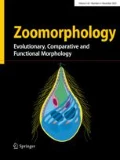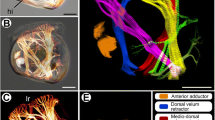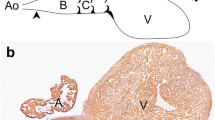Abstract
Ecteinascidia turbinata is a colonial ascidian that as an adult shares characters with phlebobranch ascidians, whereas the larvae are similar to aplousobranch ascidian larvae. The sarcotubular complex consists of invaginations of the sarcolemma that contact the sarcoplasmatic reticulum via dyads or triads. If present, the invaginations of the sarcolemma in tunicates have been characterized as laminar or tubular. We comparatively investigated the sarcotubular complex of E. turbinata and seven other tunicate species using 3D-reconstruction techniques based on electron micrographs of serial sections. The mononucleate muscle cells in E. turbinata possess intermediate and close junctions and contain several layers of peripheral myofibrillae. The myofibrillae are surrounded by continuous cisternae of the sarcoplasmic reticulum that forms interconnected rings around the z-bands. The invaginations of the sarcolemma are laminar, contacting the sarcoplasamatic reticulum at the height of the z-bands via dyads and triads. We present a clear definition of character states encountered in Tunicata: laminar invaginations are characterized by a width to length ratio of smaller than 1:20, tubular invagination by a width to length ratio of larger than 1:10. Laminar invaginations are found in stolidobranch ascidians and E. turbinata. Tubular invaginations are present in aplousobranch ascidians and appendicularians. This character state distribution across taxa supports the hypothesis that E. turbinata should be included in Phlebobranchiata as suggested by adult characters and that the larval similarities with Aplousobranchiata arose by convergent evolution.








Similar content being viewed by others
References
Berrill NJ (1936) Studies in tunicate development. Part V. The evolution and classification of ascidians. Philos Trans R Soc Lond 226:43–70. doi:10.1098/rstb.1936.0002
Bone Q, Ryan KP (1975) On the presence of a transverse system in tunicate muscle. Am Zool 56:271–277
Bone Q, Flood PR, Mackie GO, Singla CL (1977) On the organization of the sarcotubular system in the caudal muscle cells of larvaceans (Tunicata). Am Zool 58:187–196
Burighel P, Cloney RA (1997) Urochordata: Ascidiacea. In: Harrison FW, Ruppert EE, Microscopic anatomy of invertebrates, Vol. 15. Hemichordata, Chaetognatha, and the invertebrate chordates. Wiley-Liss, New York, pp 221–347
Burighel P, Nunzi GM, Schiaffino S (1977) A comparative study of the organization of the sarcotubular system in ascidian muscle. J Morphol 153:205–224. doi:10.1002/jmor.1051530204
Cameron CB, Garey JR, Swall BJ (2000) Evolutionn of the chordate body plan: new insights from phylogenetic analyses of deuterostome phyla. Proc Natl Acad Sci USA 97:4469–4474. doi:10.1073/pnas.97.9.4469
Castellani C, Camatini M, Donin LL (1972) Aspetti ultrastrutturali dell muscolatura di ascidia. 1st Lombardo Rend Sci 106:59–72
Cavey MJ, Cloney RA (1972) Fine structure and differentiation of ascidian muscle. I. Differentiated caudal musculature of Distaplia occidentalis tadpoles. J Morphol 138:349–374. doi:10.1002/jmor.1051380304
Cavey MJ, Cloney RA (1973) Differentiation of the complex sarcoplasmic reticulum in caudal muscle cells of an ascidian tadpole larva. Am Zool 13:1323
Cavey MJ, Cloney RA (1974) Fine structure and differentiation of ascidian muscle. II. Morphometrics and differentiation of the caudal muscle cells of Distaplia occidentalis tadpoles. J Morphol 144:23–70. doi:10.1002/jmor.1051440104
Cavey MJ, Cloney RA (1976) Ultrastructure and differentiation of ascidian muscle. I. Caudal musculature of the larva of Diplosoma macdonaldi. Cell Tissue Res 174:289–313. doi:10.1007/BF00220677
Cavey MJ, Strecker HD (1985) Ultrastructure of the caudal muscle cells in the larva of a polyclinid ascidian. Can J Zool 63:1410–1419
Dehal P, Satou Y, Campbell RK, Chapman J, Degnan B, De Tomaso A et al (2002) The draft genome of Ciona intestinalis: insights into chordate and vertebrate origins. Science 298:2157–2167. doi:10.1126/science.1080049
Delsuc F, Brinkmann H, Chourrout D, Philippe H (2006) Tunicates and not cephalochordates are the closest living relatives of vertebrates. Nature 439:965–968. doi:10.1038/nature04336
Garstang W (1928) The morphology of the Tunicata and its bearing on the phylogeny of the Chordata. Q J Microsc Sci 72:51–187
Hernández-Zanuy A, García-Cagide A, Esquivel M, Blanco A (2000) Reproducción y desarrollo de Ecteinascidia turbinata (Ascidiacea: Perophoridae) en Cuba. Rev Biol Trop 48:193–199
Kott P (1985) The Australian Ascidiacea. Part I, Phlebobranchiata and Stolidobranchiata. Mem Queensl Mus 23:1–440
Kott P (1990) The Australian Ascidiacea. Part II, Aplousobranchiata (1). Mem Queensl Mus 29:1–298
Martonosi AN (2000) The development of sarcoplasmic reticulum. Harwood Academic Publishers, Amsterdam, p 632
Martonosi AN, Pikula S (2003) The network of calcium regulation in muscle. A Biochim Pol 50:1–30
Monniot C, Monniot F (1972) Clé mondiale des genres d’ascidies. Arch Zool Exp Gén 113:311–367
Nielsen C (1997) Tail evolution. Science 277:1422. doi:10.1126/science.277.5331.1421b
Quinn KE, Castellani L, Ondrias K, Ehrlich BE (1998) Characterization of the ryanodine receptor/channel of invertebrate muscle. Am J Physiol Regul Integr Comp Physiol 274:494–502
Seeliger O (1885) Die Entwicklungsgeschichte der socialen Ascidien. Jenaische Zeitschr Naturw 18:45–120
Stach T (2005) Comparison of the serotonergic nervous system among Tunicata: implications for its evolution within Chordata. ODE 5:14–25
Stach T (2007) Ontogeny of the appendicularian Oikopleura dioica Fol, 1872 reveals characters similar to ascidian larvae with sessile adults. Zoomorphology 126:203–214. doi:10.1007/s00435-007-0041-5
Stach T, Turbeville JM (2002) Phylogeny of Tunicata inferred from molecular and morphological characters. Mol Phylogenet Evol 25:408–428. doi:10.1016/S1055-7903(02)00305-6
Stach T, Winter J, Bouquet J-M, Chourrout D, Schnabel R (2008) Embryology of a planktonic tunicate reveals traces of sessility. Proc Natl Acad Sci USA 105:7229–7234. doi:10.1073/pnas.0710196105
Swalla BJ, Jeffery WR (1996) Requirement of the Manx gene for expression of chordate features in a tailless ascidian larva. Science 274:1205–1208. doi:10.1126/science.274.5290.1205
Swalla BJ, Smith AB (2008) Deciphering deuterostome phylogeny: molecular, morphological and palaeontological perspectives. Philos Trans R Soc B 363:1557–1568. doi:10.1098/rstb.2007.2246
Swalla BJ, Cameron CB, Corley LS, Garey JR (2000) Urochordates are monophyletic within the deuterostomes. Syst Biol 49:52–64. doi:10.1080/10635150050207384
Van Name WG (1945) The North and South American ascidians. Bull Am Mus Nat Hist 84:1–476
Wada H (1998) Evolutionary history of free-swimming and sessile lifestyles in urochordates as deduced from 18s rDNA molecular phylogeny. Mol Biol Evol 15:1189–1194
Webb DA (1939) Observations on the blood of certain ascidians, with special reference to the biochemistry of vanadium. J Exp Zool 16:499–522
Zeng L, Jacobs MW, Swalla BJ (2006) Coloniality has evolved once in stolidobranch ascidians. Integr Comp Biol 46:255–268. doi:10.1093/icb/icj035
Acknowledgments
We thank Peter Adam for skillfully drawing Fig. 7. Financial support for this study through grant Sta 655/1-1&2 of the Deutsche Forschungsgemeinschaft is gratefully acknowledged.
Author information
Authors and Affiliations
Corresponding author
Additional information
An erratum to this article can be found at http://dx.doi.org/10.1007/s00435-008-0083-3
Rights and permissions
About this article
Cite this article
Stach, T., Kirbach, A. Larval convergence in a colonial tunicate: the organization of the sarcotubular complex in Ecteinascidia turbinata (Perophoridae, Phlebobranchiata, Tunicata, Chordata). Zoomorphology 128, 1–11 (2009). https://doi.org/10.1007/s00435-008-0069-1
Received:
Revised:
Accepted:
Published:
Issue Date:
DOI: https://doi.org/10.1007/s00435-008-0069-1




